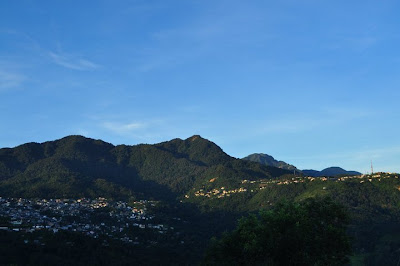
We just returned from our two-day journey way out into rural areas of the jungle en route to the University of Nagaland. As we drove from Kohima through the regions of Wokha, Zunheboto, and Mokochung, I started to understand, if maybe for the first time, that we really were moving from one tribe to the next, village by village. In the Ao tribe alone, for example, there are 75 villages. We knew we were entering a new village when we passed under the welcome sign on each decorative gate. As we left each village, we would pass through a second gate with beautifully, hand-painted messages such as “Thank You” and “Safe Journeys”. We knew which tribe we were in (scratch that--Mele explained to us) that we could tell which tribe we were in by the tribe-specific patterns and colors on the shawls that many of the people had wrapped around their shoulders.
There were also checkpoints, where men (young and old) sat with machine guns in arms reach of a rope pulley that would raise or lower a hinged wooden gate (similar to the ones at ticket booths on our highways). The gates were always up. We never stopped at the stop signs. Mele told us that the only reason they might stop us is to ask for a photograph. At night, the police guards were either reading by candlelight inside the booth or gathered around a campfire outside. Our Restricted Access Zone permit (copied 25 times and spread out over three bags within arms reach at any time), have thus far been used to take notes.
The most terrifying experience that we have had thus far—one that I will l put in the category of most terrifying experiences I have had in my life—was the drive from here (Kohima) to Lumami. Imagine the most “curvy” road that you have ever been on. Tighten the curves to fit quadruple the number of switchbacks in the same length of space that you are imagining. Add enough potholes to erase the idea that there is a flat plane at all. Make a few of the potholes so deep that they require switchbacks themselves. Add hundred feet cliffs that starting immediately at the edge of the road. Subtract guardrails. Make it a one-way path. Add cars coming the other direction at record speeds. Drive it at 65 kilometers per hour.
When Brian and I walked into the lecture hall at the University, all of the students stood up and clapped. We both gave lectures on our work, followed by at least an hour of conversation with faculty and students. The questions were less about our research and more about our motivations for coming to Nagaland, what it was like for students in America, and what we would tell people about them when we returned. The conversations ended when one student (all the way in the back) stood up and said, “Please tell them that we are not headhunters; we are hunters of knowledge.”
When we returned to the bungalow last night, Theja and Angel had lemon tea, chicken soup, Asian noodles, and cans of cold, underground beer (Fosters) waiting. We sat around the fire in their kitchen and talked and laughed until after 10pm. When we got back to our room, a hot pillow-like thing was already warming the covers. New towels were folded. The flames from the fireplace gave an orange glow across wood floors.





 FIVE DAYS AND COUNTING!!!
FIVE DAYS AND COUNTING!!!








